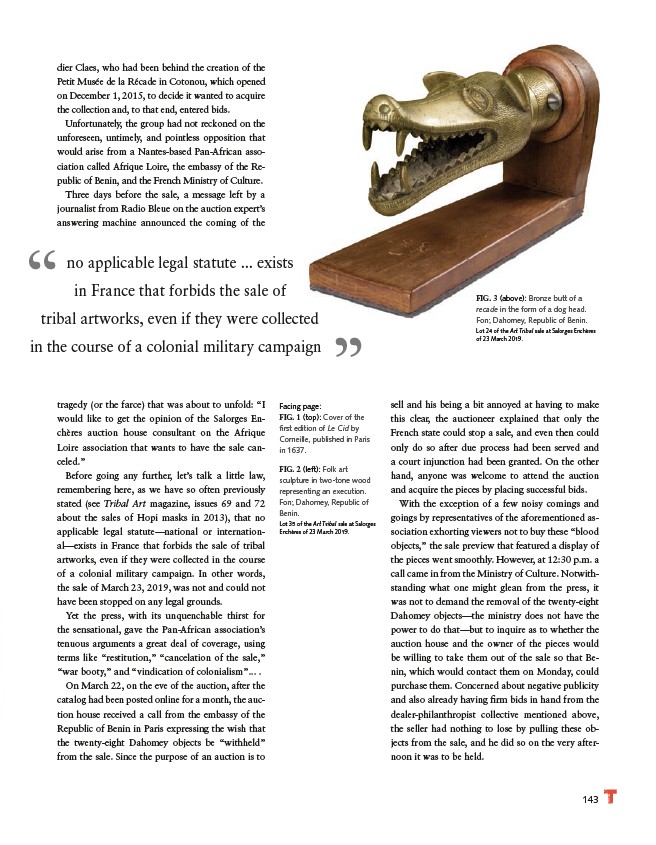
sell and his being a bit annoyed at having to make
this clear, the auctioneer explained that only the
French state could stop a sale, and even then could
only do so after due process had been served and
a court injunction had been granted. On the other
hand, anyone was welcome to attend the auction
and acquire the pieces by placing successful bids.
With the exception of a few noisy comings and
goings by representatives of the aforementioned association
exhorting viewers not to buy these “blood
objects,” the sale preview that featured a display of
the pieces went smoothly. However, at 12:30 p.m. a
call came in from the Ministry of Culture. Notwithstanding
what one might glean from the press, it
was not to demand the removal of the twenty-eight
Dahomey objects—the ministry does not have the
power to do that—but to inquire as to whether the
auction house and the owner of the pieces would
be willing to take them out of the sale so that Benin,
which would contact them on Monday, could
purchase them. Concerned about negative publicity
and also already having firm bids in hand from the
dealer-philanthropist collective mentioned above,
the seller had nothing to lose by pulling these objects
from the sale, and he did so on the very afternoon
it was to be held.
143
“
tragedy (or the farce) that was about to unfold: “I
would like to get the opinion of the Salorges Enchères
auction house consultant on the Afrique
Loire association that wants to have the sale canceled.”
Before going any further, let’s talk a little law,
remembering here, as we have so often previously
stated (see Tribal Art magazine, issues 69 and 72
about the sales of Hopi masks in 2013), that no
applicable legal statute—national or international—
exists in France that forbids the sale of tribal
artworks, even if they were collected in the course
of a colonial military campaign. In other words,
the sale of March 23, 2019, was not and could not
have been stopped on any legal grounds.
Yet the press, with its unquenchable thirst for
the sensational, gave the Pan-African association’s
tenuous arguments a great deal of coverage, using
terms like “restitution,” “cancelation of the sale,”
“war booty,” and “vindication of colonialism”... .
On March 22, on the eve of the auction, after the
catalog had been posted online for a month, the auction
house received a call from the embassy of the
Republic of Benin in Paris expressing the wish that
the twenty-eight Dahomey objects be “withheld”
from the sale. Since the purpose of an auction is to
FIG. 3 (above): Bronze butt of a
recade in the form of a dog head.
Fon; Dahomey, Republic of Benin.
Lot 24 of the Art Tribal sale at Salorges Enchères
of 23 March 2019.
Facing page:
FIG. 1 (top): Cover of the
first edition of Le Cid by
Corneille, published in Paris
in 1637.
FIG. 2 (left): Folk art
sculpture in two-tone wood
representing an execution.
Fon; Dahomey, Republic of
Benin.
Lot 35 of the Art Tribal sale at Salorges
Enchères of 23 March 2019.
dier Claes, who had been behind the creation of the
Petit Musée de la Récade in Cotonou, which opened
on December 1, 2015, to decide it wanted to acquire
the collection and, to that end, entered bids.
Unfortunately, the group had not reckoned on the
unforeseen, untimely, and pointless opposition that
would arise from a Nantes-based Pan-African association
called Afrique Loire, the embassy of the Republic
of Benin, and the French Ministry of Culture.
Three days before the sale, a message left by a
journalist from Radio Bleue on the auction expert’s
answering machine announced the coming of the
no applicable legal statute ... exists
in France that forbids the sale of
tribal artworks, even if they were collected
in the course of a colonial military campaign
“